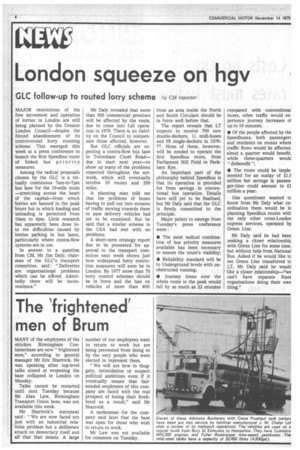London squeeze on hgv
Page 6

If you've noticed an error in this article please click here to report it so we can fix it.
GLC follow-up to routed lorry scheme 5y CM reporter MAJOR restrictions of the free movement and operation of lorries in London are still being planned by the Greater London Council—despite the forced abandonment of its controversial lorry routeing scheme. This emerged this week at a press conference to launch the first Speedbus route of linked bus priority measures.
Among the radical proposals chosen by the GLC is a virtually continuous 7am-to-7pm bus lane for the 10-mile route —stretching across the heart of the capital—from which lorries are banned in the peak hours but in which loading and unloading is permitted from 10am to 4pm. Little research has apparently been done into the difficulties caused by lorries parking in bus lanes, particularly where contra-flow systems are in use.
In answer to a question from CM, Mr Jim Daly, chairman of the GLC's transport committee, said : "Deliveries are organisational problems which can be solved. Admittedly there will be inconvenience." Mr Daly revealed that more than 500 commercial premises will be affected by the route, due to come into full operation in 1978. There is no liability on the Council to compensate those affected, however.
But GLC officials are expecting a contra-flow bus lane in Tottenham Court Road— due to start next year—to show up many of the problems expected throughout the network, which will eventually involve 10 routes and 200 miles.
A planning man told me that the problems of buses having to pull out into streams of traffic moving towards them to pass delivery vehicles had yet to be examined. But he said that a similar scheme in the USA had met with no problems.
A short-term strategy report due to be presented for approval to the transport committee next week shows just how widespread lorry restriction measures will soon be in London. By 1977 more than 70 lorry control schemes should be in force and the ban on vehicles of more than 40ft from an area inside the North and South Circulars should be in force well before that.
The report reveals that LT expects to receive 700 new double-deckers, 11 midi-buses and 95 single-deckers in 19777. None of these, however, will be needed to operate the first Speedbus route, from Parliament Hill Field to Peckham Rye.
An important part of the philosophy behind Speedbus is that its operation is provided for from savings in conventional bus operation. Details have still yet to be finalised, but Mr Daly said that the GLC is firmly committed to the principle.
Major points to emerge from Tuesday's press conference were : • The most radical combination of bus priority measures available has been necessary to ensure the route's viability; • Reliability standard will be to Underground levels with unobstructed running; • Journey times over the whole route in the peak would fall by as much as 22 minutes compared with conventional buses, other traffic would experience journey increases of up to 10 minutes; • Of the people affected by the Speedbuses, both passengers and residents on routes where traffic flows would be affected about a quarter would benefit, while three-quarters would " disbenefit "; • The route could be implemented for an outlay of £1.f. million but savings in passenger-time could amount to E1 million a year.
One questioner wanted tc know from Mr Daly what coordination there would be ir planning Speedbus routes witt. the only other cross-London express services, operated by Green Line.
Mr Daly said he had been seeking a closer relationshir with Green Line for some time, but without help from National Bus. Asked if he would like to see Green Line transferred tc LT, Mr Daly said he would like a closer relationship—"we can't have separate State organisations doing their own thing."




























































































































